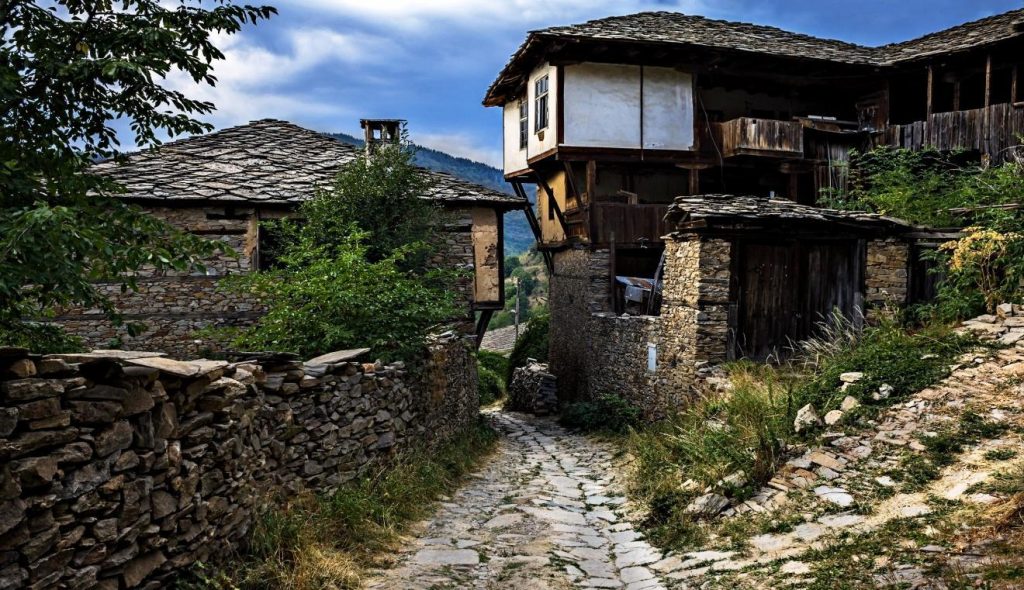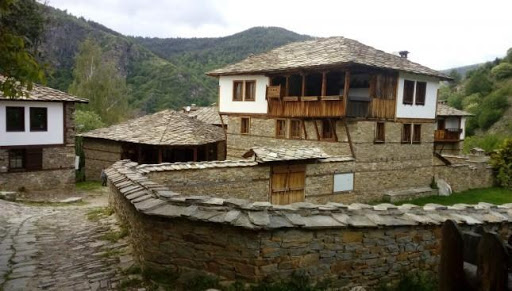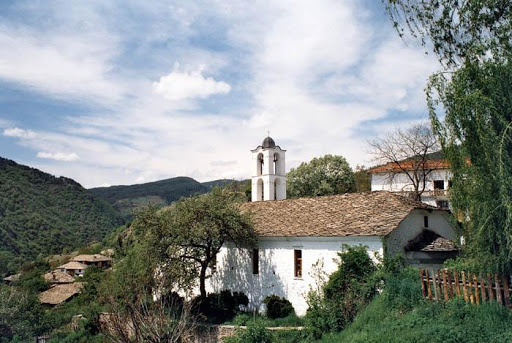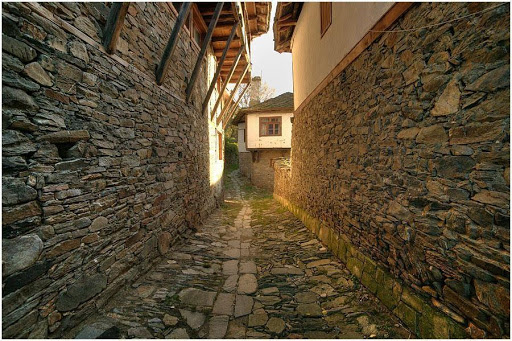If you are visiting Bansko and you would like to see the area, we suggest you to go on a day trip to one of the most distinctive and beautiful villages in Bulgaria – Kovatchevitca village.
The village is located about 24 kilometers away from the town of Gotse Delchev, 8 km away from Leshten village and 64 km away from the town of Bansko.
The village is nestled in the embrace of Western Rhodope Mountain, on both sides of Kanina River (Bloody River), and it is impressive with its narrow, cobblestone streets and unique architecture. Here the time seems to go with its own course, and the sights that will be revealed before your eyes will remain forever in your heart.
Alhough today in Kovatchevica are living not more than 37 people, the silence is not as loud as in other less populated villages. In the village of Kovatchevitca silence brings calmness and peace of the spirit.

History of Kovatchevitca
Although the village has been mentioned for the first time in Turkish records in XVI – XVII century, it has a much longer and ancient history. According to local historians, the first settlers in the territory of today’s village came after the invasion of the Turkish hordes in Bulgaria. After the fall ot Tarnovo kingdom, a large group of people from the newly enslaved regions of the country found shelter in the village and formed several neighborhoods.
The next large settling of Kovatchevitca was during the time of the forcible conversion to Mohammedanism of the Bulgarian population in the Rhodope Mountain. At that time, people from the close Ribnovo village that was almost entirely burned, and people from Bansko found their second home in Kovatchevica. Later on, in the XVIII century, several wealthy families from the Aegean Greece (Western Macedonia) came to the village and formed the Arnautska neighborhood.
The residents of Kovatchevitca were proud and protected their home and their faith at the cost of everything. Maybe that’s why the village never had a Turkish administration and a mosque.
During the Bulgarian Revival Period, the population of Kovatchevica village was over 600 Bulgarians, and the place was one of the most important educational and religious centers in the region. The crafts flourished in the region, the trade was also well-developed, and traders from the village travelled all over Europe and they were respected everywhere as honest and responsible people. The masonry was the most developed of all the crafts in Kovatchevitca.
Thanks to the unique building school of Kovatchevitca, which has no analogue in the country, nowadays Kovatchevitca village attracts tourists from all around the world, who come to the village not only because of its beautiful nature, but also because of the incredible ensembles of stone houses.
Legend of Kovatchevitca
One of the most popular legends that local people will tell you is about the name of the village. According to this legend, a blacksmith lived in the village, and after his death his wife took his place in the smithy. When her relatives and friends came to visit her, they said: „I am going to Kovatchevitca”. So, slowly the name „Kovatchevitca” became the name not only of the hardworking wife of the blacksmith, but also of the village where she lived.

Sights that you can see in Kovatchevitca village
For many years the village has attracted many tourists from the country and abroad because of its numerous attractions, beautiful nature and most of all due to its unique architecture. In 1977 the village was declared a historical and architectural reserve. And there is a reason for that!
From the moment you step on the village square, you will go back in time. The feeling you will experience as you walk through the narrow, cobblestone streets simply cannot be described. Here everything is made of stone… the streets are of stone, the houses are built almost entirely of stone, even their roofs are covered with stone plates.
The houses were built in XVIII and XIX century by the representatives of the bulding and architectural school of Kovatchevitca. As we mentioned, this school has no other analogue, which makes the stone ensembles in Kovatchevitca invaluable monuments of the Bulgarian revival architecture.
Almost all houses in the village are built on two floors, as the first floor was for the animals and storage of food, and the second floor was the residential floor. The typical house in Kovatchevitca has a large yard that is surrounded by a large stone fence with a heavy wooden gate.
According to the specialists, the fact that the houses in Kovatchevitca are made of stone is one of the reasons to be preserved in their completely authentic appearance to this day.
In addition to the incredible architecture of the houses, Kovatchevitca will also impress you with one of its biggest sights – the „Saint Nicholas”church.
The three-nave pseudo-basilica was built between 1841 and 1848, as all residents of the village took part in its construction and did the best they could.
The legend tells that when the village people decided to build the temple, the Turkish authorities refused to give them the permit for the construction. Then a local merchant who was also a famous barber to meet the sultan and ask for a building permit.
Since he was a really good barber and he was famous even in Istanbul, the merchant managed to receive the permit personally from the Sultan, who allowed the church to be built but under one condition – to be low so that it would not be seen from afar.
The residents of Kovatchevitca respected this condition and they built their temple low, but they made it big enough and wide, and they made a great decoration. Although it is not painted from inside, even nowadays the church impresses with the distribution of space, with its huge carved iconostasis and with the 12 icons from the middle of the XIX century, most probably work of the painters from the Tryavna Zograf School. Two valuable icons can be seen in the temple – „Saint George on horseback” and „Saint Dimitar on horseback”, which are work of Georgi Sterguv from the Bansko Art School.
In 1900 in the yard of the church was built a 12-meter bell tower, and the Alexovi brothers donated two bells, as the melodic sound that they make can still be heard also today during big holidays. There was also a clock placed on the bell tower, but unfortunately it has not been preserved until the present day.
The church school is located close to the church, and there the children of Kovatchevitca village have been taught how to write and read in the XVIII century, which is also worth visiting.
Although there are few permanent residents of the village nowadays, Kovatchevitca offers a lot of places both for accommodation and for eating. The atmosphere in the numerous small restaurants is very cozy and nice, and the food that you can try there is very delicious.
If you have time and desire for more walks, several tourist routes start from the village.

„Sini vir” Tourist route
If you decide to take a short walk to „Sini vir”, you have to go to the center of the village, where you will find a signpost and route information sign. You can reach the waterfall if you follow a forest path (which is steep in places) for an hour, but once you reach it, you will forget all difficulties that you had on the road.
„Sini vir” is an incredibly beautiful cascade of waterfalls and rapids, as the water falls down from inaccessible rocks into the waters of Kanina River. Upon their fall, the water has carved several formations as the biggest and most beautiful is called Sini vir.
You can reach the area following a by-pass road, but you will need about 3 hours walking through the forest paths. This route also starts from the center of the village, but unlike the short one, it goes almost entirely along the bed of the river against its flow.
Route Kovatchevitca – „Saint George” chapel
The chapel is located about 3 kilometers away to the east of the village, and in order to get there you will need about an hour. „Saint George” was built in 1995 at one of the highest places over Kovatchevitca and nowadays is one of the most visited and honored monuments of culture in the region. The chapel is built entirely by voluntary work of local masters. A 10-meter cross rises up close to it so you can also see it.
Many other tourist trails and routes start from Kovatchevitca such as „Kovatchevitca – „Kozi kamuk”area, „Kovatchevitca – Beslet peak” and others.
If you have enough time, do not miss to see the nearby Leshten village and Ognyanovo village.
Leshten is incredibly beautiful and old village, which just like Kovatchevitca will charm you with its unique architecture of the houses of the Revival period, with its quiet cobblestone streets and beautiful nature. Do not miss to see also the unique clay house that is located at the end of the village, as it seems to have come out of the novel „Lord of the rings”.
Ognyanovo village is famous for its mineral baths and in recent years it has become one of the most popular tourist destinations in the country. Here you can try something delicious in one of the small restaurants, but you can also spend one hour or two in one of the numerous mineral pools.

How to get to Kovatchevitca village?
If you are travelling from Bansko, you have to leave the town and take the road to Dobrinishte and drive along the main road. You will pass through the villages Ognyanovo, Garmen and Leshten. About 8 km from Leshten you will reach your final destination – Kovatchevitca village. The distance from Bansko to Kovatchevitca is 64 km and you will need about an hour and 15 minutes to get there.
If you travel from the town of Gotse Delchev, you have to leave the town and drive to Garmen-Leshten. The distance from Gotse Delchev to Kovatchevitca is about 22 km and you will need 30 – 35 minutes to get there.